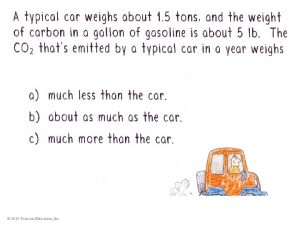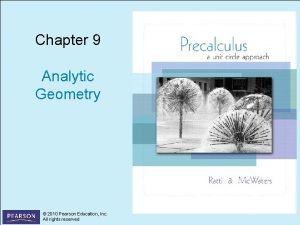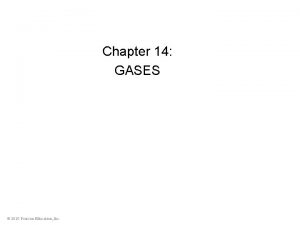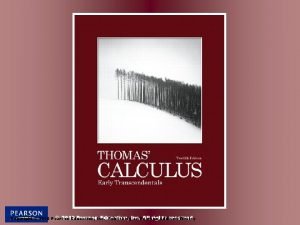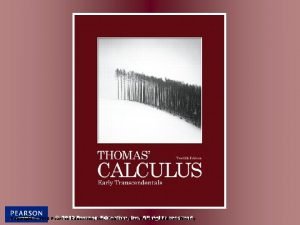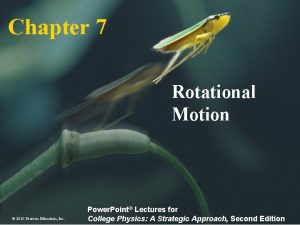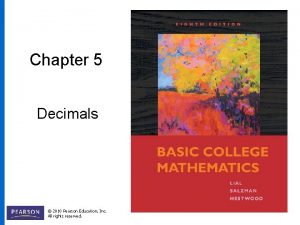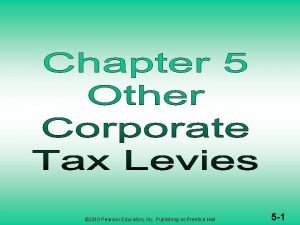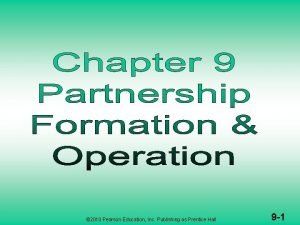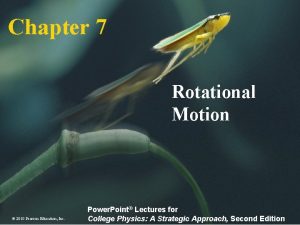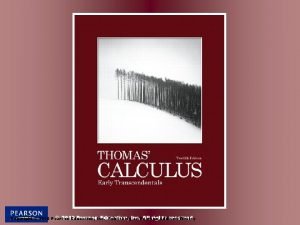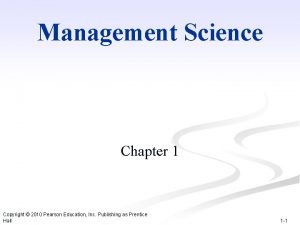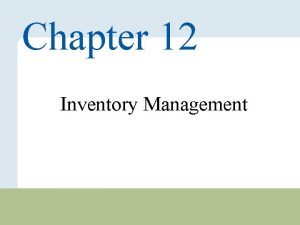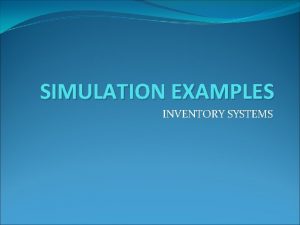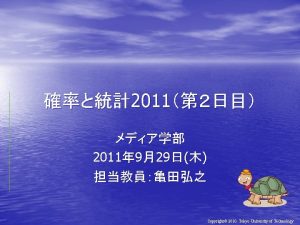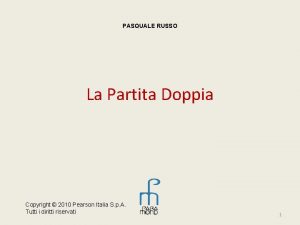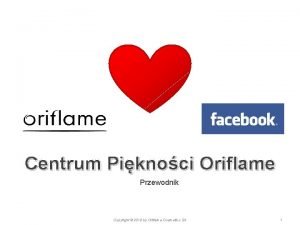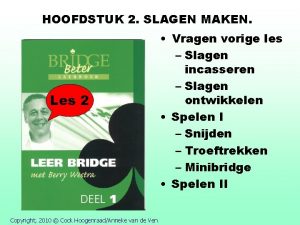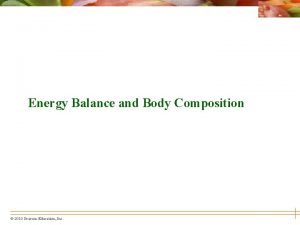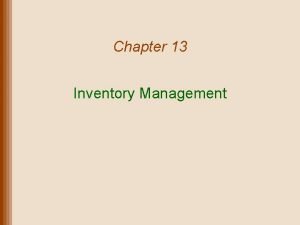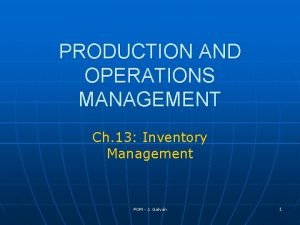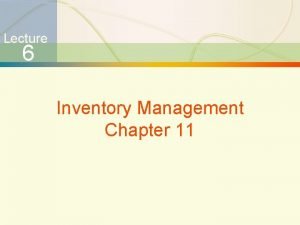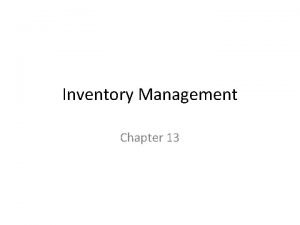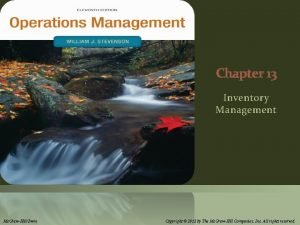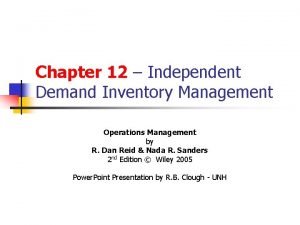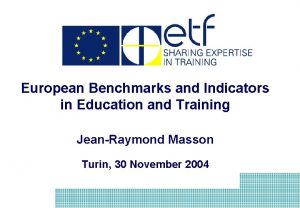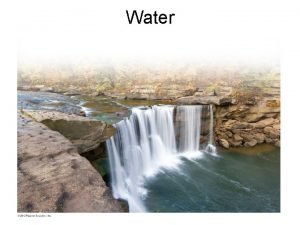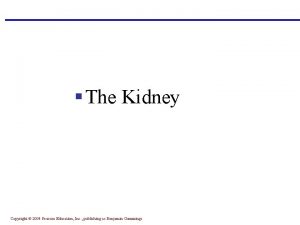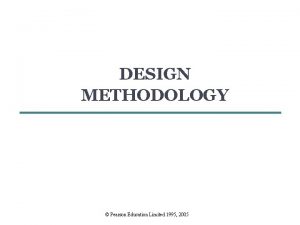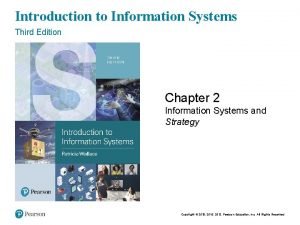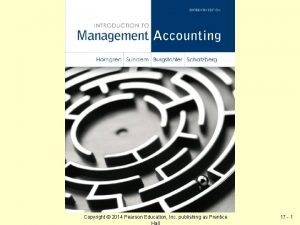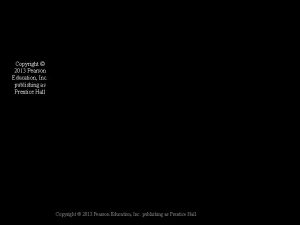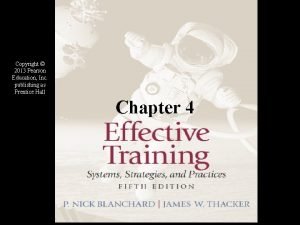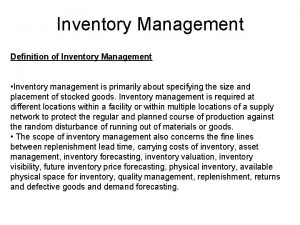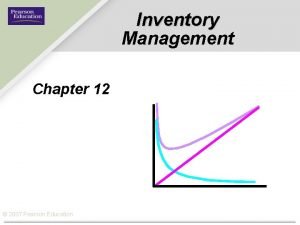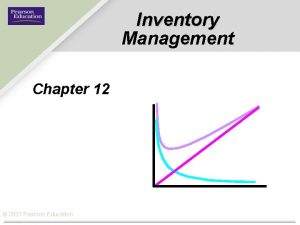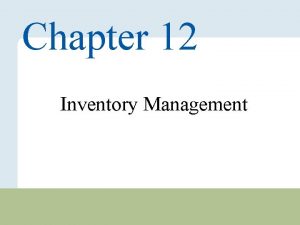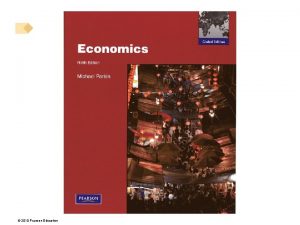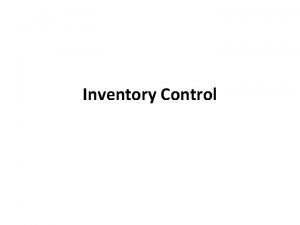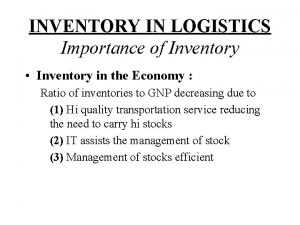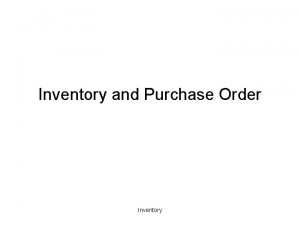Chapter 12 Inventory Management Copyright 2010 Pearson Education























































































- Slides: 87

Chapter 12 Inventory Management Copyright © 2010 Pearson Education, Inc. Publishing as Prentice Hall. 12 – 1

Inventory Management l Inventories are important to all types of organizations u They have to be counted, paid for, used in operations, used to satisfy customers, and managed u Too much inventory reduces profitability u Too little inventory damages customer confidence Copyright © 2010 Pearson Education, Inc. Publishing as Prentice Hall. 12 – 2

ABC Analysis l Stock-keeping units (SKU) l Identify the classes so management can control inventory levels u Class A: ~20% of items, ~80% annual $ usage u Class B: ~30% of items, ~15% annual $ usage u Class C: ~50% of items, ~5% annual $ usage Copyright © 2010 Pearson Education, Inc. Publishing as Prentice Hall. 12 – 3

ABC Analysis Percentage of dollar value 100 — Class C Class B 90 — Class A 80 — 70 — 60 — 50 — 40 — 30 — 20 — 10 — 0— 10 20 30 40 50 60 70 80 90 100 Percentage of SKUs Figure 12. 1 – Typical Chart Using ABC Analysis Copyright © 2010 Pearson Education, Inc. Publishing as Prentice Hall. 12 – 4

Problem #2 (page 441) Item Annual Demand Unit cost A 104 40. 25 D 205 80. 75 120 X 104 10. 00 150 U 404 40. 50 150 L 205 60. 70 50 S 104 80. 20 20 X 205 80. 15 20 L 104 20. 05 100 80 12 – 5

Problem #2 (page 441) Item Annual Demand Unit cost Annual $ Usage A 104 40. 25 80 3, 220 D 205 80. 75 120 9, 690 X 104 10. 00 150 1, 500 U 404 40. 50 150 6, 075 L 205 60. 70 50 3, 035 S 104 80. 20 20 1, 604 X 205 80. 15 20 1, 603 L 104 20. 05 100 2, 005 28, 732 12 – 6

Problem #2 (page 441) Item Unit cost Demand $ Usage D 205 80. 75 120 9, 690 U 404 40. 50 150 6, 075 A 104 40. 25 80 3, 220 L 205 60. 70 50 3, 035 L 104 20. 05 100 2, 005 S 104 80. 20 20 1, 604 X 205 80. 15 20 1, 603 X 104 10. 00 150 1, 500 28, 732 12 – 7

Problem #2 (page 441) Unit cost Demand $ Usage % of $ usage D 205 80. 75 120 9, 690 33. 7% U 404 40. 50 150 6, 075 21. 1% A 104 40. 25 80 3, 220 11. 2% L 205 60. 70 50 3, 035 10. 6% L 104 20. 05 100 2, 005 7. 0% S 104 80. 20 20 1, 604 5. 6% X 205 80. 15 20 1, 603 5. 6% X 104 10. 00 150 1, 500 5. 2% Item 28, 732 12 – 8

Problem #2 (page 441) Unit cost Demand $ Usage % of $ usage D 205 80. 75 120 9, 690 33. 7% U 404 40. 50 150 6, 075 21. 1% 54. 9% A 104 40. 25 80 3, 220 11. 2% 66. 1% L 205 60. 70 50 3, 035 10. 6% 76. 6% L 104 20. 05 100 2, 005 7. 0% 83. 6% S 104 80. 20 20 1, 604 5. 6% 89. 2% X 205 80. 15 20 1, 603 5. 6% 94. 8% X 104 10. 00 150 1, 500 5. 2% 100. 0% Item 28, 732 Cum. % Class 12 – 9

Problem #2 (page 441) Unit cost Demand $ Usage % of $ usage D 205 80. 75 120 9, 690 33. 7% U 404 40. 50 150 6, 075 21. 1% 54. 9% A 104 40. 25 80 3, 220 11. 2% 66. 1% L 205 60. 70 50 3, 035 10. 6% 76. 6% L 104 20. 05 100 2, 005 7. 0% 83. 6% S 104 80. 20 20 1, 604 5. 6% 89. 2% X 205 80. 15 20 1, 603 5. 6% 94. 8% X 104 10. 00 150 1, 500 5. 2% 100. 0% Item 28, 732 Cum. % Class A 12 – 10

Problem #2 (page 441) Unit cost Demand $ Usage % of $ usage D 205 80. 75 120 9, 690 33. 7% U 404 40. 50 150 6, 075 21. 1% 54. 9% A 104 40. 25 80 3, 220 11. 2% 66. 1% L 205 60. 70 50 3, 035 10. 6% 76. 6% L 104 20. 05 100 2, 005 7. 0% 83. 6% C S 104 80. 20 20 1, 604 5. 6% 89. 2% C X 205 80. 15 20 1, 603 5. 6% 94. 8% C X 104 10. 00 150 1, 500 5. 2% 100. 0% C Item 28, 732 Cum. % Class A 12 – 11

Problem #2 (page 441) Unit cost Demand $ Usage % of $ usage D 205 80. 75 120 9, 690 33. 7% A U 404 40. 50 150 6, 075 21. 1% 54. 9% A A 104 40. 25 80 3, 220 11. 2% 66. 1% B L 205 60. 70 50 3, 035 10. 6% 76. 6% B L 104 20. 05 100 2, 005 7. 0% 83. 6% C S 104 80. 20 20 1, 604 5. 6% 89. 2% C X 205 80. 15 20 1, 603 5. 6% 94. 8% C X 104 10. 00 150 1, 500 5. 2% 100. 0% C Item 28, 732 Cum. % Class 12 – 12

Economic Order Quantity l The lot size, Q, that minimizes total annual inventory holding and ordering costs l Five assumptions 1. Demand rate is constant and known with certainty 2. No constraints are placed on the size of each lot 3. The only two relevant costs are the inventory holding cost and the fixed cost per lot for ordering or setup 4. Decisions for one item can be made independently of decisions for other items 5. The lead time is constant and known with certainty Copyright © 2010 Pearson Education, Inc. Publishing as Prentice Hall. 12 – 13

Economic Order Quantity l Don’t use the EOQ u Make-to-order strategy u Order size is constrained l Modify the EOQ u Quantity discounts u Replenishment not instantaneous l Use the EOQ u Make-to-stock u Carrying and setup costs are known and relatively stable Copyright © 2010 Pearson Education, Inc. Publishing as Prentice Hall. 12 – 14

Calculating EOQ On-hand inventory (units) Receive order Inventory depletion (demand rate) Q Average cycle inventory Q 2 1 cycle Time Figure 12. 2 – Cycle-Inventory Levels Copyright © 2010 Pearson Education, Inc. Publishing as Prentice Hall. 12 – 15

Calculating EOQ l Annual holding cost = (Average cycle inventory) (Unit holding cost) = (Q/2) H l Annual ordering cost = (Number of orders/Year) (Ordering or setup costs) (D/Q) S l Total annual cycle-inventory cost Total costs = Annual holding cost + Annual ordering or setup cost Copyright © 2010 Pearson Education, Inc. Publishing as Prentice Hall. 12 – 16

Annual cost (dollars) Calculating EOQ Total cost = (Q/2)H + (D/Q)S Holding cost = (Q/2)H Ordering cost = (D/Q)S Lot Size (Q) Figure 12. 3 – Graphs of Annual Holding, Ordering, and Total Costs Copyright © 2010 Pearson Education, Inc. Publishing as Prentice Hall. 12 – 17

Calculating EOQ l Total annual cycle-inventory cost Q D C= (H) + (S) Q 2 EOQ = 2 DS H where C = total annual cycle-inventory cost Q = lot size H = holding cost per unit per year D = annual demand S = ordering or setup costs per lot Copyright © 2010 Pearson Education, Inc. Publishing as Prentice Hall. 12 – 18

Calculating TBO and No. of orders l Expected number of orders (N) = D/Q l Expected time between orders (TBO) = (Q/D) x No. of periods per year = Q/d Copyright © 2010 Pearson Education, Inc. Publishing as Prentice Hall. 12 – 19

The Cost of a Lot-Sizing Policy EXAMPLE 12. 1 l A museum of natural history opened a gift shop which operates 52 weeks per year. l Managing inventories has become a problem. l Top-selling SKU is a bird feeder. l Sales are 18 units per week, the supplier charges $60 per unit. l Ordering cost is $45. l Annual holding cost is 25 percent of a feeder’s value. Copyright © 2010 Pearson Education, Inc. Publishing as Prentice Hall. 12 – 20

Finding the EOQ, Total Cost, TBO SOLUTION We begin by computing the annual demand holding cost as D = (18 units/week)(52 weeks/year) = 936 units H = 0. 25($60/unit) = $15 Using the formulas for EOQ and annual cost, we get EOQ = C= 2 DS H = Q D (H) + (S) 2 Q 2(936)(45) 15 C= = 74. 94 or 75 units 75 936 (15) + (45) 2 75 C = $1, 124. 10 Copyright © 2010 Pearson Education, Inc. Publishing as Prentice Hall. 12 – 21

The Cost of a Lot-Sizing Policy Figure 12. 4 – Total Annual Cycle-Inventory Cost Function for the Bird Feeder Current cost Annual cost (dollars) 3000 – Total Q D = (H) + (S) cost 2 Q 2000 – Q Holding cost = (H) 2 1000 – Ordering cost = Lowest cost 0– | | 50 100 Best Q (EOQ) | | | 150 200 250 300 350 Lot Size (Q) Copyright © 2010 Pearson Education, Inc. Publishing as Prentice Hall. D (S) Q | 400 12 – 22

Finding the EOQ, Total Cost, TBO When the EOQ is used, the TBO can be expressed in various ways for the same time period. TBOEOQ = Q d No. of orders per year = Copyright © 2010 Pearson Education, Inc. Publishing as Prentice Hall. = 75 = 4. 17 weeks 18 D EOQ = 936 = 12. 48 orders 75 12 – 23

Application 12. 1 Suppose that you are reviewing the inventory policies on an $80 item stocked at a hardware store. The current policy is to replenish inventory by ordering in lots of 360 units. Additional information is: D = 60 units per week, or 3, 120 units per year S = $30 per order H = 25% of selling price, or $20 per unit per year What is the EOQ? SOLUTION EOQ = 2 DS H = Copyright © 2010 Pearson Education, Inc. Publishing as Prentice Hall. 2(3, 120)(30) = 97 units 20 12 – 24

Application 12. 1 What is the total annual cost of the current policy (Q = 360), and how does it compare with the cost with using the EOQ? Current Policy EOQ Policy Q = 360 units Q = 97 units C = (360/2)(20) + (3, 120/360)(30) C = (97/2)(20) + (3, 120/97)(30) C = 3, 600 + 260 C = 970 + 965 C = $3, 860 C = $1, 935 Copyright © 2010 Pearson Education, Inc. Publishing as Prentice Hall. 12 – 25

Application 12. 1 What is the time between orders (TBO) for the current policy and the EOQ policy, expressed in weeks? SOLUTION TBO 360 = TBOEOQ = 360 (52 weeks per year) = 6 weeks 3, 120 97 (52 weeks per year) = 1. 6 weeks 3, 120 Copyright © 2010 Pearson Education, Inc. Publishing as Prentice Hall. 12 – 26

Managerial Insights TABLE 12. 1 Parameter | SENSITIVITY ANALYSIS OF THE EOQ Parameter Change EOQ Change Comments ↑ ↑ Increase in lot size is in proportion to the square root of D. Demand 2 DS H Order/Setup Costs 2 DS H ↓ ↓ Weeks of supply decreases and inventory turnover increases because the lot size decreases. Holding Costs 2 DS H ↓ ↑ Larger lots are justified when holding costs decrease. Copyright © 2010 Pearson Education, Inc. Publishing as Prentice Hall. 12 – 27

Inventory Control Systems l Two important questions: u How much? u When? l Nature of demand u Independent demand u Dependent demand Copyright © 2010 Pearson Education, Inc. Publishing as Prentice Hall. 12 – 28

Inventory Control Systems l Continuous review (Q) system u Reorder point system (ROP) and fixed order quantity system u For independent demand items u Tracks inventory position (IP) u Includes scheduled receipts (SR), on-hand inventory (OH), and back orders (BO) Inventory position = On-hand inventory + Scheduled receipts – Backorders IP = OH + SR – BO Copyright © 2010 Pearson Education, Inc. Publishing as Prentice Hall. 12 – 29

Selecting the Reorder Point IP On-hand inventory Order received IP Order received Q OH OH IP Order received Q OH R Order placed L TBO L Time TBO Figure 12. 6 – Q System When Demand Lead Time Are Constant and Certain Copyright © 2010 Pearson Education, Inc. Publishing as Prentice Hall. 12 – 30

Application 12. 2 The on-hand inventory is only 10 units, and the reorder point R is 100. There are no backorders and one open order for 200 units. Should a new order be placed? SOLUTION IP = OH + SR – BO = 10 + 200 – 0 = 210 R = 100 Decision: Place no new order Copyright © 2010 Pearson Education, Inc. Publishing as Prentice Hall. 12 – 31

Placing a New Order EXAMPLE 12. 3 Demand for chicken soup at a supermarket is always 25 cases a day and the lead time is always 4 days. The shelves were just restocked with chicken soup, leaving an on-hand inventory of only 10 cases. No backorders currently exist, but there is one open order in the pipeline for 200 cases. What is the inventory position? Should a new order be placed? SOLUTION R =Total demand during lead time = (25)(4) = 100 cases IP = OH + SR – BO = 10 + 200 – 0 = 210 cases Copyright © 2010 Pearson Education, Inc. Publishing as Prentice Hall. 12 – 32

Continuous Review Systems l Selecting the reorder point with variable demand constant lead time Reorder point =Average demand during lead time + Safety stock =d. L + safety stock where d = average demand per week (or day or months) L = constant lead time in weeks (or days or months) Copyright © 2010 Pearson Education, Inc. Publishing as Prentice Hall. 12 – 33

Continuous Review Systems IP Order received On-hand inventory Order received IP IP Order received Q Q Q R Order placed 0 L 1 TBO 1 L 2 TBO 2 L 3 Time TBO 3 Figure 12. 7 – Q System When Demand Is Uncertain Copyright © 2010 Pearson Education, Inc. Publishing as Prentice Hall. 12 – 34

Reorder Point 1. Choose an appropriate service-level policy u Select service level or cycle service level u Protection interval 2. Determine the demand during lead time probability distribution 3. Determine the safety stock and reorder point levels Copyright © 2010 Pearson Education, Inc. Publishing as Prentice Hall. 12 – 35

Demand During Lead Time l Specify mean and standard deviation l Standard deviation of demand during lead time σd. LT = σd 2 L = σd L l Safety stock and reorder point Safety stock = zσd. LT where z =number of standard deviations needed to achieve the cycle-service level σd. LT =stand deviation of demand during lead time Reorder point = R = d. L + safety stock = d. L + zσd. LT Copyright © 2010 Pearson Education, Inc. Publishing as Prentice Hall. 12 – 36

Demand During Lead Time σt = 15 + 75 Demand for week 1 + 75 Demand for week 2 σt = 15 = 75 Demand for week 3 σt = 25. 98 225 Demand for 3 -week lead time Copyright © 2010 Pearson Education, Inc. Publishing as Prentice Hall. Figure 12. 8 – Development of Demand Distribution for the Lead Time 12 – 37

Demand During Lead Time Cycle-service level = 85% Probability of stockout (1. 0 – 0. 85 = 0. 15) Average demand during lead time R zσd. LT Figure 12. 9 – Finding Safety Stock with a Normal Probability Distribution for an 85 Percent Cycle-Service Level Copyright © 2010 Pearson Education, Inc. Publishing as Prentice Hall. 12 – 38

Reorder Point for Variable Demand EXAMPLE 12. 4 Let us return to the bird feeder in Example 12. 2. The EOQ is 75 units. Suppose that the average demand is 18 units per week with a standard deviation of 5 units. The lead time is constant at two weeks. Determine the safety stock and reorder point if management wants a 90 percent cycleservice level. Copyright © 2010 Pearson Education, Inc. Publishing as Prentice Hall. 12 – 39

Reorder Point for Variable Demand SOLUTION In this case, σd = 5, d = 18 units, and L = 2 weeks, so σd. LT = σd L = 5 2 = 7. 07. Consult the body of the table in the Normal Distribution appendix for 0. 9000, which corresponds to a 90 percent cycle-service level. The closest number is 0. 8997, which corresponds to 1. 2 in the row heading and 0. 08 in the column heading. Adding these values gives a z value of 1. 28. With this information, we calculate the safety stock and reorder point as follows: Safety stock = zσd. LT = 1. 28(7. 07) = 9. 05 or 9 units Reorder point = d. L + Safety stock = 2(18) + 9 = 45 units 75 936 C = ($15) + ($45) + 9($15) = 2 75 C = $562. 50 + $561. 60 + $135 = $1259. 10 Copyright © 2010 Pearson Education, Inc. Publishing as Prentice Hall. 12 – 40

Application 12. 3 Suppose that the demand during lead time is normally distributed with an average of 85 and σd. LT = 40. Find the safety stock, and reorder point R, for a 95 percent cycle-service level. SOLUTION Safety stock = zσd. LT = 1. 645(40) = 65. 8 or 66 units R = Average demand during lead time + Safety stock R = 85 + 66 = 151 units Find the safety stock, and reorder point R, for an 85 percent cycle-service level. Safety stock = zσd. LT = 1. 04(40) = 41. 6 or 42 units R = Average demand during lead time + Safety stock R = 85 + 42 = 127 units Copyright © 2010 Pearson Education, Inc. Publishing as Prentice Hall. 12 – 41

Reorder Point for Variable Demand Lead Time l Often the case that both are variable l The equations are more complicated Safety stock = zσd. LT R =(Average weekly demand Average lead time) + Safety stock =d. L + Safety stock where d =Average weekly (or daily or monthly) demand L =Average lead time σd =Standard deviation of weekly (or daily or monthly) demand σLT =Standard deviation of the lead time σd. LT = Lσd 2 + d 2σLT 2 Copyright © 2010 Pearson Education, Inc. Publishing as Prentice Hall. 12 – 42

Reorder Point EXAMPLE 12. 5 The Office Supply Shop estimates that the average demand for a popular ball-point pen is 12, 000 pens per week with a standard deviation of 3, 000 pens. The current inventory policy calls for replenishment orders of 156, 000 pens. The average lead time from the distributor is 5 weeks, with a standard deviation of 2 weeks. If management wants a 95 percent cycleservice level, what should the reorder point be? Copyright © 2010 Pearson Education, Inc. Publishing as Prentice Hall. 12 – 43

Reorder Point SOLUTION We have d = 12, 000 pens, σd = 3, 000 pens, L = 5 weeks, and σLT = 2 weeks σd. LT = Lσd 2 + d 2σLT 2 = (5)(3, 000)2 + (12, 000)2(2)2 = 24, 919. 87 pens From the Normal Distribution appendix for 0. 9500, the appropriate z value = 1. 65. We calculate the safety stock and reorder point as follows: Safety stock = zσd. LT = (1. 65)(24, 919. 87) = 41, 117. 79 or 41, 118 pens Reorder point = d. L + Safety stock = (12, 000)(5) + 41, 118 = 101, 118 pens Copyright © 2010 Pearson Education, Inc. Publishing as Prentice Hall. 12 – 44

Application 12. 4 Grey Wolf lodge is a popular 500 -room hotel in the North Woods. Managers need to keep close tabs on all of the room service items, including a special pint-scented bar soap. The daily demand for the soap is 275 bars, with a standard deviation of 30 bars. Ordering cost is $10 and the inventory holding cost is $0. 30/bar/year. The lead time from the supplier is 5 days, with a standard deviation of 1 day. The lodge is open 365 days a year. What should the reorder point be for the bar of soap if management wants to have a 99 percent cycle-service? Copyright © 2010 Pearson Education, Inc. Publishing as Prentice Hall. 12 – 45

Application 12. 4 SOLUTION d =275 bars L =5 days σd =30 bars σLT =1 day σd. LT = Lσd 2 + d 2σLT 2 = 283. 06 bars From the Normal Distribution appendix for 0. 9900, z = 2. 33. We calculate the safety stock and reorder point as follows; Safety stock = zσd. LT = (2. 33)(283. 06) = 659. 53 or 660 bars Reorder point + safety stock = d. L + safety stock = (275)(5) + 660 = 2, 035 bars Copyright © 2010 Pearson Education, Inc. Publishing as Prentice Hall. 12 – 46

Continuous Review Systems l Two-Bin system u Visual system u An empty first bin signals the need to place an order l Calculating total systems costs Total cost = Annual cycle inventory holding cost + Annual ordering cost + Annual safety stock holding cost Q D C= (H) + (S) + (H) (Safety stock) Q 2 Copyright © 2010 Pearson Education, Inc. Publishing as Prentice Hall. 12 – 47

Application 12. 5 The Discount Appliance Store uses a continuous review system (Q system). One of the company’s items has the following characteristics: Demand = 10 units/wk (assume 52 weeks per year) Ordering and setup cost (S) = $45/order Holding cost (H) = $12/unit/year Lead time (L) = 3 weeks (constant) Standard deviation in weekly demand = 8 units Cycle-service level = 70% Copyright © 2010 Pearson Education, Inc. Publishing as Prentice Hall. 12 – 48

Application 12. 5 SOLUTION What is the EOQ for this item? D = 10/wk 52 wks/yr = 520 units EOQ = 2 DS H = 2(520)(45) = 62 units 12 What is the desired safety stock? σd. LT = σd L = 8 3 = 14 units Safety stock = zσd. LT = 0. 525(14) = 8 units Copyright © 2010 Pearson Education, Inc. Publishing as Prentice Hall. 12 – 49

Application 12. 5 What is the desired reorder point R? R = Average demand during lead time + Safety stock R = 3(10) + 8 = 38 units What is the total annual cost? 62 520 C= ($12) + ($45) + 8($12) = $845. 42 2 62 Copyright © 2010 Pearson Education, Inc. Publishing as Prentice Hall. 12 – 50

Application 12. 5 Suppose that the current policy is Q = 80 and R = 150. What will be the changes in average cycle inventory and safety stock if your EOQ and R values are implemented? Reducing Q from 80 to 62 Cycle inventory reduction = 40 – 31 = 9 units Safety stock reduction = 120 – 8 = 112 units Reducing R from 150 to 38 Copyright © 2010 Pearson Education, Inc. Publishing as Prentice Hall. 12 – 51

Periodic Review System (P) l Fixed interval reorder system or periodic reorder system l Four of the original EOQ assumptions maintained u No constraints are placed on lot size u Holding and ordering costs u Independent demand u Lead times are certain l Order is placed to bring the inventory position up to the target inventory level, T, when the predetermined time, P, has elapsed Copyright © 2010 Pearson Education, Inc. Publishing as Prentice Hall. 12 – 52

Periodic Review System (P) On-hand inventory T IP Q 1 IP Order received OH Order received Q 2 IP Q 3 Order received OH IP 1 IP 3 Order placed IP 2 L L P L Time P Protection interval Figure 12. 10 – P System When Demand Is Uncertain Copyright © 2010 Pearson Education, Inc. Publishing as Prentice Hall. 12 – 53

How Much to Order in a P System EXAMPLE 12. 6 A distribution center has a backorder for five 36 -inch color TV sets. No inventory is currently on hand, and now is the time to review. How many should be reordered if T = 400 and no receipts are scheduled? SOLUTION IP = OH + SR – BO = 0 + 0 – 5 = – 5 sets T – IP = 400 – (– 5) = 405 sets That is, 405 sets must be ordered to bring the inventory position up to T sets. Copyright © 2010 Pearson Education, Inc. Publishing as Prentice Hall. 12 – 54

Application 12. 6 The on-hand inventory is 10 units, and T is 400. There are no back orders, but one scheduled receipt of 200 units. Now is the time to review. How much should be reordered? SOLUTION IP = OH + SR – BO = 10 + 200 – 0 = 210 T – IP = 400 – 210 = 190 The decision is to order 190 units Copyright © 2010 Pearson Education, Inc. Publishing as Prentice Hall. 12 – 55

P System – Variable demand, Constant LT l IP covers demand over a protection interval of P+L l Use P+L in place of L in the ROP formula (d. L + zσd. LT ) u The average demand during the protection interval is d(P + L), or T = d(P + L) + safety stock for protection interval Safety stock = zσP + L , where σP + L = T = d(P + L) + z Copyright © 2010 Pearson Education, Inc. Publishing as Prentice Hall. 12 – 56

Calculating P and T EXAMPLE 12. 7 Again, let us return to the bird feeder example. Recall that demand for the bird feeder is normally distributed with a mean of 18 units per week and a standard deviation in weekly demand of 5 units. The lead time is 2 weeks, and the business operates 52 weeks per year. The Q system developed in Example 12. 4 called for an EOQ of 75 units and a safety stock of 9 units for a cycle-service level of 90 percent. What is the equivalent P system? Answers are to be rounded to the nearest integer. Copyright © 2010 Pearson Education, Inc. Publishing as Prentice Hall. 12 – 57

Calculating P and T SOLUTION We first define D and then P. Here, P is the time between reviews, expressed in weeks because the data are expressed as demand per week: D = (18 units/week)(52 weeks/year) = 936 units EOQ 75 P= (52) = 4. 2 or 4 weeks D 936 With d = 18 units per week, an alternative approach is to calculate P by dividing the EOQ by d to get 75/18 = 4. 2 or 4 weeks. Either way, we would review the bird feeder inventory every 4 weeks. Copyright © 2010 Pearson Education, Inc. Publishing as Prentice Hall. 12 – 58

Calculating P and T We now find the standard deviation of demand over the protection interval (P + L) = 6: Before calculating T, we also need a z value. For a 90 percent cycle-service level z = 1. 28. The safety stock becomes Safety stock = zσP + L = 1. 28(12. 25) = 15. 68 or 16 units We now solve for T: T = Average demand during the protection interval + Safety stock = d(P + L) + safety stock = (18 units/week)(6 weeks) + 16 units = 124 units Copyright © 2010 Pearson Education, Inc. Publishing as Prentice Hall. 12 – 59

Periodic Review System l Use simulation when both demand lead time are variable l Suitable to single-bin systems l Total costs for the P system are the sum of the same three cost elements as in the Q system l Order quantity and safety stock are calculated differently d. P D C= (H) + (S) + HzσP + L d. P 2 4(18) 936 C = ($15) + ($45) + 15($15) 2 4(18) C = $540 + $585 + $225 = $1350 Copyright © 2010 Pearson Education, Inc. Publishing as Prentice Hall. 12 – 60

Application 12. 7 Return to Discount Appliance Store (Application 12. 4), but now use the P system for the item. Previous information Demand = 10 units/wk (assume 52 weeks per year) = 520 EOQ = 62 units (with reorder point system) Lead time (L) = 3 weeks Standard deviation in weekly demand = 8 units z = 0. 525 (for cycle-service level of 70%) Reorder interval P, if you make the average lot size using the Periodic Review System approximate the EOQ. Copyright © 2010 Pearson Education, Inc. Publishing as Prentice Hall. 12 – 61

Application 12. 7 SOLUTION Reorder interval P, if you make the average lot size using the Periodic Review System approximate the EOQ. P = (EOQ/D)(52) = (62/529)(52) = 6. 2 or 6 weeks Safety stock = Target inventory T = d(P + L) + safety stock for protection interval T = 10(6 + 3) + 13 = 103 units Copyright © 2010 Pearson Education, Inc. Publishing as Prentice Hall. 12 – 62

Application 12. 7 Total cost d. P D C = 2 (H) + (S) + HzσP + L d. P 10(6) 520 = ($12) + ($45) + (13)($12) = $906. 00 10(6) 2 Copyright © 2010 Pearson Education, Inc. Publishing as Prentice Hall. 12 – 63

Comparative Advantages l Primary advantages of P systems u Convenient u Orders u Only can be combined need to know IP when review is made l Primary advantages of Q systems u Review u Fixed frequency may be individualized lot sizes can result in quantity discounts u Lower safety stocks Copyright © 2010 Pearson Education, Inc. Publishing as Prentice Hall. 12 – 64

Hybrid systems l Optional replenishment systems u Optimal review, min-max, or (s, S) system, like the P system u Reviews IP at fixed time intervals and places a variablesized order to cover expected needs u Ensures that a reasonable large order is placed l Base-stock system u Replenishment order is issued each time a withdrawal is made u Order quantities vary to keep the inventory position at R u Minimizes cycle inventory, but increases ordering costs u Appropriate for expensive items Copyright © 2010 Pearson Education, Inc. Publishing as Prentice Hall. 12 – 65

Solved Problem 1 Booker’s Book Bindery divides SKUs into three classes, according to their dollar usage. Calculate the usage values of the following SKUs and determine which is most likely to be classified as class A. SKU Number Description 1 Boxes 2 Quantity Used per Year Unit Value ($) 500 3. 00 Cardboard (square feet) 18, 000 0. 02 3 Cover stock 10, 000 0. 75 4 Glue (gallons) 75 40. 00 5 Inside covers 20, 000 0. 05 6 Reinforcing tape (meters) 3, 000 0. 15 7 Signatures 150, 000 0. 45 Copyright © 2010 Pearson Education, Inc. Publishing as Prentice Hall. 12 – 66

Solved Problem 1 SOLUTION The annual dollar usage for each item is determined by multiplying the annual usage quantity by the value per unit. As shown in Figure 12. 11, the SKUs are then sorted by annual dollar usage, in declining order. Finally, A–B and B–C class lines are drawn roughly, according to the guidelines presented in the text. Here, class A includes only one SKU (signatures), which represents only 1/7, or 14 percent, of the SKUs but accounts for 83 percent of annual dollar usage. Class B includes the next two SKUs, which taken together represent 28 percent of the SKUs and account for 13 percent of annual dollar usage. The final four SKUs, class C, represent over half the number of SKUs but only 4 percent of total annual dollar usage. Copyright © 2010 Pearson Education, Inc. Publishing as Prentice Hall. 12 – 67

Solved Problem 1 SKU Number Description Quantity Used per Year Unit Value ($) Annual Dollar Usage ($) 500 3. 00 = 1, 500 Cardboard (square feet) 18, 000 0. 02 = 360 3 Cover stock 10, 000 0. 75 = 7, 500 4 Glue (gallons) 75 40. 00 = 3, 000 5 Inside covers 20, 000 0. 05 = 1, 000 6 Reinforcing tape (meters) 3, 000 0. 15 = 450 7 Signatures 150, 000 0. 45 = 67, 500 Total 81, 310 1 Boxes 2 Copyright © 2010 Pearson Education, Inc. Publishing as Prentice Hall. 12 – 68

Solved Problem 1 Class B Percentage of Dollar Value 100 – Class C 90 –Class A 80 – 70 – 60 – 50 – 40 – Figure 12. 11 – Annual Dollar Usage for Class A, B, and C SKUs Using Tutor 12. 2 30 – 20 – 10 – 0– 10 20 30 40 50 60 70 80 90 100 Percentage of SKUs Copyright © 2010 Pearson Education, Inc. Publishing as Prentice Hall. 12 – 69

Solved Problem 2 Nelson’s Hardware Store stocks a 19. 2 volt cordless drill that is a popular seller. Annual demand is 5, 000 units, the ordering cost is $15, and the inventory holding cost is $4/unit/year. a. What is the economic order quantity? b. What is the total annual cost for this inventory item? SOLUTION a. The order quantity is EOQ = 2 DS H = 2(5, 000)($15) $4 = 37, 500 = 193. 65 or 194 drills b. The total annual cost is Q D 194 5, 000 C= (H) + (S) = ($4) + ($15) = $774. 60 Q 2 2 194 Copyright © 2010 Pearson Education, Inc. Publishing as Prentice Hall. 12 – 70

Solved Problem 3 A regional distributor purchases discontinued appliances from various suppliers and then sells them on demand to retailers in the region. The distributor operates 5 days per week, 52 weeks per year. Only when it is open for business can orders be received. Management wants to reevaluate its current inventory policy, which calls for order quantities of 440 counter-top mixers. The following data are estimated for the mixer: Average daily demand (d) = 100 mixers Standard deviation of daily demand (σd) = 30 mixers Lead time (L) = 3 days Holding cost (H) = $9. 40/unit/year Ordering cost (S) = $35/order Cycle-service level = 92 percent The distributor uses a continuous review (Q) system Copyright © 2010 Pearson Education, Inc. Publishing as Prentice Hall. 12 – 71

Solved Problem 3 a. What order quantity Q, and reorder point, R, should be used? b. What is the total annual cost of the system? c. If on-hand inventory is 40 units, one open order for 440 mixers is pending, and no backorders exist, should a new order be placed? Copyright © 2010 Pearson Education, Inc. Publishing as Prentice Hall. 12 – 72

Solved Problem 3 SOLUTION a. Annual demand is D = (5 days/week)(52 weeks/year)(100 mixers/day) = 26, 000 mixers/year The order quantity is EOQ = 2 DS = H = Copyright © 2010 Pearson Education, Inc. Publishing as Prentice Hall. 2(26, 000)($35) $9. 40 193, 167 = 440. 02 or 440 mixers 12 – 73

Solved Problem 3 The standard deviation of the demand during lead time distribution is σd. LT = σd L = 30 3 = 51. 96 A 92 percent cycle-service level corresponds to z = 1. 41 Safety stock = zσd. LT = 1. 41(51. 96 mixers) = 73. 26 or 73 mixers Average demand during lead time = d. L = 100(3) = 300 mixers Reorder point (R) = Average demand during lead time + Safety stock = 300 mixers + 73 mixers = 373 mixers With a continuous review system, Q = 440 and R = 373 Copyright © 2010 Pearson Education, Inc. Publishing as Prentice Hall. 12 – 74

Solved Problem 3 b. The total annual cost for the Q systems is Q D C= (H) + Q (S) + (H)(Safety stock) 2 C= 26, 000 440 ($9. 40) + ($35) + ($9. 40)(73) = $4, 822. 38 440 2 c. Inventory position = On-hand inventory + Scheduled receipts – Backorders IP = OH + SR – BO = 40 + 440 – 0 = 480 mixers Because IP (480) exceeds R (373), do not place a new order Copyright © 2010 Pearson Education, Inc. Publishing as Prentice Hall. 12 – 75

Solved Problem 4 Suppose that a periodic review (P) system is used at the distributor in Solved Problem 3, but otherwise the data are the same. a. Calculate the P (in workdays, rounded to the nearest day) that gives approximately the same number of orders per year as the EOQ. b. What is the target inventory level, T? Compare the P system to the Q system in Solved Problem 3. c. What is the total annual cost of the P system? d. It is time to review the item. On-hand inventory is 40 mixers; receipt of 440 mixers is scheduled, and no backorders exist. How much should be reordered? Copyright © 2010 Pearson Education, Inc. Publishing as Prentice Hall. 12 – 76

Solved Problem 4 SOLUTION a. The time between orders is P= EOQ 440 (260 days/year) = (260) = 4. 4 or 4 days D 26, 000 b. Figure 12. 12 shows that T = 812 and safety stock = (1. 41)(79. 37) = 111. 91 or about 112 mixers. The corresponding Q system for the counter-top mixer requires less safety stock. Figure 12. 12 – OM Explorer Solver for Inventory Systems Copyright © 2010 Pearson Education, Inc. Publishing as Prentice Hall. 12 – 77

Solved Problem 4 c. The total annual cost of the P system is d. P D C = 2 (H) + (S) + (H)(Safety stock) d. P 100(4) 26, 000 C= ($9. 40) + ($35) + ($9. 40)(1. 41)(79. 37) 100(4) 2 = $5, 207. 80 d. Inventory position is the amount on hand plus scheduled receipts minus backorders, or IP = OH + SR – BO = 40 + 440 – 0 = 480 mixers The order quantity is the target inventory level minus the inventory position, or Q = T – IP = 812 mixers – 480 mixers = 332 mixers An order for 332 mixers should be placed. Copyright © 2010 Pearson Education, Inc. Publishing as Prentice Hall. 12 – 78

Solved Problem 5 Grey Wolf Lodge is a popular 500 -room hotel in the North Woods. Managers need to keep close tabs on all room service items, including a special pine-scented bar soap. The daily demand for the soap is 275 bars, with a standard deviation of 30 bars. Ordering cost is $10 and the inventory holding cost is $0. 30/bar/year. The lead time from the supplier is 5 days, with a standard deviation of 1 day. The lodge is open 365 days a year. a. What is the economic order quantity for the bar of soap? b. What should the reorder point be for the bar of soap if management wants to have a 99 percent cycle-service level? c. What is the total annual cost for the bar of soap, assuming a Q system will be used? Copyright © 2010 Pearson Education, Inc. Publishing as Prentice Hall. 12 – 79

Solved Problem 5 SOLUTION a. We have D = (275)(365) = 100, 375 bars of soap; S = $10; and H = $0. 30. The EOQ for the bar of soap is EOQ = 2 DS = H = Copyright © 2010 Pearson Education, Inc. Publishing as Prentice Hall. 2(100, 375)($10) $0. 30 6, 691, 666. 7 = 2, 586. 83 or 2, 587 bars 12 – 80

Solved Problem 5 b. We have d = 275 bars/day, σd = 30 bars, L = 5 days, and σLT = 1 day. σd. LT = Lσd 2 + d 2σLT 2 = (5)(30)2 + (275)2(1)2 = 283. 06 bars Consult the body of the Normal Distribution appendix for 0. 9900. The closest value is 0. 9901, which corresponds to a z value of 2. 33. We calculate the safety stock and reorder point as follows: Safety stock = zσd. LT = (2. 33)(283. 06) = 659. 53 or 660 bars Reorder point = d. L + Safety stock = (275)(5) + 660 = 2, 035 bars Copyright © 2010 Pearson Education, Inc. Publishing as Prentice Hall. 12 – 81

Solved Problem 5 c. The total annual cost for the Q system is Q D C= (H) + Q (S) + (H)(Safety stock) 2 2, 587 100, 375 C= ($0. 30) + ($10) + ($0. 30)(660) = $974. 05 2 2, 587 Copyright © 2010 Pearson Education, Inc. Publishing as Prentice Hall. 12 – 82

Solved Problem 6 Zeke’s Hardware Store sells furnace filters. The cost to place an order to the distributor is $25 and the annual cost to hold a filter in stock is $2. The average demand per week for the filters is 32 units, and the store operates 50 weeks per year. The weekly demand for filters has the probability distribution shown on the left below. The delivery lead time from the distributor is uncertain and has the probability distribution shown on the right below. Suppose Zeke wants to use a P system with P = 6 weeks and a cycle-service level of 90 percent. What is the appropriate value for T and the associated annual cost of the system? Copyright © 2010 Pearson Education, Inc. Publishing as Prentice Hall. 12 – 83

Solved Problem 6 Demand Probability Lead Time (wks) Probability 24 0. 15 1 0. 05 28 0. 20 2 0. 25 32 0. 30 3 0. 40 36 0. 20 4 0. 25 40 0. 15 5 0. 05 Copyright © 2010 Pearson Education, Inc. Publishing as Prentice Hall. 12 – 84

Solved Problem 6 SOLUTION Figure 12. 13 contains output from the Demand During the Protection Interval Simulator from OM Explorer. Figure 12. 13 – OM Explorer Solver for Demand during the Protection Interval Copyright © 2010 Pearson Education, Inc. Publishing as Prentice Hall. 12 – 85

Solved Problem 6 Given the desired cycle-service level of 90 percent, the appropriate T value is 322 units. The simulation estimated the average demand during the protection interval to be 289 units, consequently the safety stock is 322 – 289 = 33 units. The annual cost of this P system is C= 6(32) 50(32) ($2) + ($25) + (33)($2) 2 6(32) = $192. 00 + $208. 33 + $66. 00 = $466. 33 Copyright © 2010 Pearson Education, Inc. Publishing as Prentice Hall. 12 – 86

Solved Problem 7 Consider Zeke’s inventory in Solved Problem 6. Suppose that he wants to use a continuous review (Q) system for the filters, with an order quantity of 200 and a reorder point of 140. Initial inventory is 170 units. If the stockout cost is $5 per unit, and all of the other data in Solved Problem 6 are the same, what is the expected cost per week of using the Q system? SOLUTION Figure 12. 14 shows output from the Q System Simulator in OM Explorer. Only weeks 1 through 13 and weeks 41 through 50 are shown in the figure. The average total cost per week is $305. 62. Notice that no stockouts occurred in this simulation. These results are dependent on Zeke’s choices for the reorder point and lot size. It is possible that stockouts would occur if the simulation were run for more than 50 weeks. Copyright © 2010 Pearson Education, Inc. Publishing as Prentice Hall. 12 – 87
 2010 pearson education inc
2010 pearson education inc Copyright 2010 pearson education inc
Copyright 2010 pearson education inc Copyright 2010 pearson education inc
Copyright 2010 pearson education inc Copyright 2010 pearson education inc
Copyright 2010 pearson education inc Copyright 2010 pearson education inc
Copyright 2010 pearson education inc Copyright 2010 pearson education inc
Copyright 2010 pearson education inc 2010 pearson education inc
2010 pearson education inc Copyright 2010 pearson education inc
Copyright 2010 pearson education inc Composition copyright example
Composition copyright example Copyright 2010 pearson education inc
Copyright 2010 pearson education inc 2017 pearson education ltd
2017 pearson education ltd 2017 pearson education inc
2017 pearson education inc Copyright 2009
Copyright 2009 2018 pearson education inc
2018 pearson education inc Copyright 2014 pearson education inc
Copyright 2014 pearson education inc Copyright by pearson education inc. answers
Copyright by pearson education inc. answers 2008 pearson education inc
2008 pearson education inc Copyright 2009 pearson education inc
Copyright 2009 pearson education inc Copyright pearson education inc
Copyright pearson education inc Copyright 2009 pearson education inc
Copyright 2009 pearson education inc Copyright 2009 pearson education inc
Copyright 2009 pearson education inc 2009 pearson education inc
2009 pearson education inc 2009 pearson education inc
2009 pearson education inc Copyright pearson education inc
Copyright pearson education inc 2010 pearson education inc
2010 pearson education inc 2010 pearson education inc
2010 pearson education inc 2010 pearson education inc answers
2010 pearson education inc answers 2010 pearson education inc answers
2010 pearson education inc answers 2010 pearson education inc answers
2010 pearson education inc answers 2010 pearson education inc
2010 pearson education inc 2010 pearson education inc
2010 pearson education inc 2010 pearson education inc
2010 pearson education inc The four forces shown have the same strength
The four forces shown have the same strength Pearson education inc 5
Pearson education inc 5 2010 pearson education inc
2010 pearson education inc Pearson education inc. publishing as prentice hall
Pearson education inc. publishing as prentice hall 2010 pearson education inc
2010 pearson education inc Two coins rotate on a turntable
Two coins rotate on a turntable 2010 pearson education inc
2010 pearson education inc 2010 pearson education inc
2010 pearson education inc 2010 pearson education inc answers
2010 pearson education inc answers 2010 pearson education inc
2010 pearson education inc 2010 pearson education inc
2010 pearson education inc Pearson education inc. all rights reserved
Pearson education inc. all rights reserved 2010 pearson education inc answers
2010 pearson education inc answers 2010 pearson education inc answers
2010 pearson education inc answers Reorder point formula example
Reorder point formula example 2010 pearson education inc
2010 pearson education inc 2011 pearson education inc
2011 pearson education inc Pearson education inc publishing as pearson prentice hall
Pearson education inc publishing as pearson prentice hall Pearson education inc publishing as pearson prentice hall
Pearson education inc publishing as pearson prentice hall Pearson 2012
Pearson 2012 2008 pearson prentice hall inc
2008 pearson prentice hall inc Inventory simulation excel
Inventory simulation excel Chapter 12 inventory management
Chapter 12 inventory management C-929-a
C-929-a Variazioni finanziarie attive
Variazioni finanziarie attive Copyright 2010
Copyright 2010 Copyright 2010
Copyright 2010 2005 pearson prentice hall inc
2005 pearson prentice hall inc Pearson 2010
Pearson 2010 Educational pearson pearson times
Educational pearson pearson times Educational pearson pearson times
Educational pearson pearson times Chapter 13 inventory management problems and solutions
Chapter 13 inventory management problems and solutions Chapter 13 inventory management
Chapter 13 inventory management Chapter 13 inventory management
Chapter 13 inventory management Chapter 13 inventory management
Chapter 13 inventory management Chapter 13 inventory management
Chapter 13 inventory management Inventory record accuracy formula
Inventory record accuracy formula National education policy 1998 to 2010 in pakistan
National education policy 1998 to 2010 in pakistan Education and training 2010
Education and training 2010 Education and training 2010
Education and training 2010 Water cycle pearson education
Water cycle pearson education Pearson education 2004
Pearson education 2004 Pearson education limited 2008
Pearson education limited 2008 Carbon cycle pearson education
Carbon cycle pearson education Pearson education limited 2005
Pearson education limited 2005 2017 pearson education ltd
2017 pearson education ltd 2017 pearson education inc
2017 pearson education inc 2017 pearson education inc
2017 pearson education inc 2017 pearson education inc
2017 pearson education inc 2017 pearson education inc
2017 pearson education inc Pearson education inc 4
Pearson education inc 4 2015 pearson education inc
2015 pearson education inc 2014 pearson education inc
2014 pearson education inc 2013 pearson education inc
2013 pearson education inc 2013 pearson education inc
2013 pearson education inc 2013 pearson education inc. answers
2013 pearson education inc. answers


























